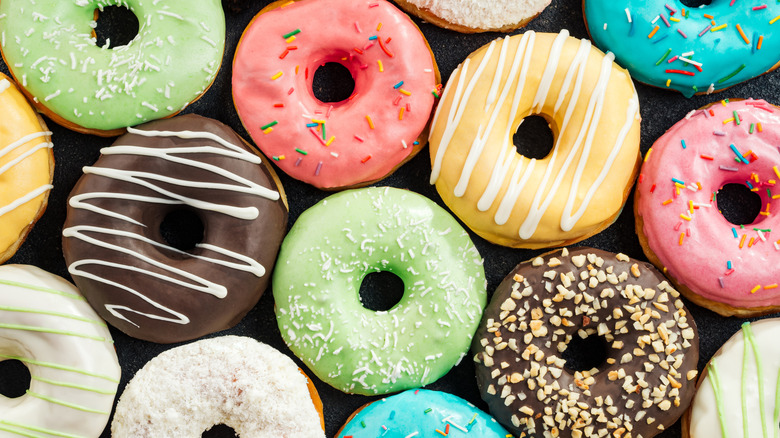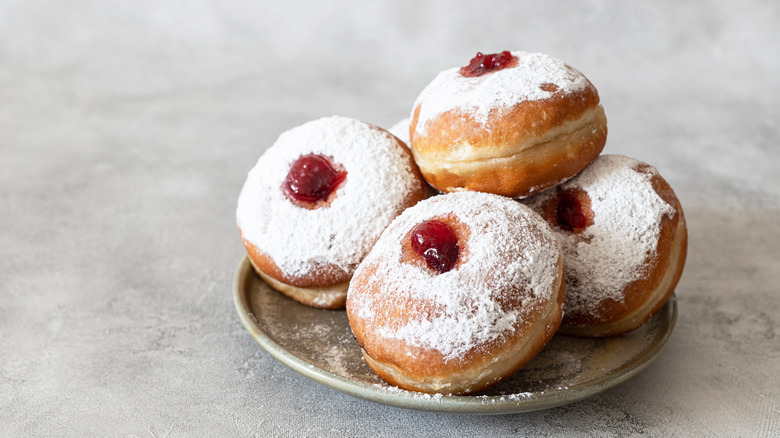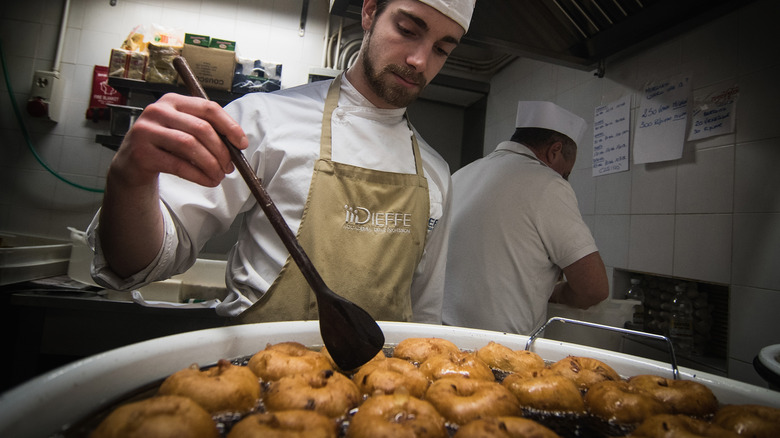The Difference Between Cake And Yeast Donuts, Explained
Even casual breakfast pastry enthusiasts know there are two key donut types: cake and yeast. And just by reading the names, you can probably intuit the basic differences between them: the former has a cake-like dough, and the latter features a more stretchy, bready base. While that's true enough, if you want to make the jump from greenhorn to expert, you'll need to dig into the taste and textural nuances between the two.
While the exact ingredients can vary, the big difference between them is that yeast donuts include a leavener: The dough for yeast donuts rises with the help of (surprise!) yeast, while cake donuts are made with baking powder, just like a typical cake batter would be. Yeast has been utilized for thousands of years in food, and while yeast donuts are much more novel than the fungus itself, they are still quite old. Traces of fried dough have been uncovered in settlements as disparate as ancient North America and Rome, but what we would recognize as something resembling the present-day donut appears to be a creation of Dutch immigrants in New York in the 17th century. Baking powder, on the other hand, is a much more recent invention, having surfaced in the middle of the 19th century, and it was followed a few decades later by the cake donut in the early 20th.
All about yeast donuts
The dough for yeast donuts (sometimes called "raised donuts") loosely resembles that of brioche. It generally contains eggs, butter, flour, sugar, milk, salt, and yeast, and is prepared in the same fashion as the French loaves: the dough is mixed, kneaded, and proofed. The donuts are then fried in oil until they're golden brown, having developed a delicate, crispy crust.
Yeast donuts tend to be lighter and puffier than their cakey counterparts because of the way they're prepared. As the flour gets wet, gluten forms, and as it's kneaded, the gluten bonds get substantially stronger. This means the gluten traps the gas that's emitted as the yeast in the dough ferments, which results in little air pockets that give them that fluffy texture. The result is something that — thanks to the milk and butter in the mix — is moist, a little chewy, and with a hint of fermented yeast flavor. Of course, the taste largely depends on how they've been filled or glazed. A yeast donut's light interior means they are easier to fill with things like cream or jelly, though a classic glaze made from powdered sugar and milk is what you tend to see sold. If you've ever been to Krispy Kreme, you've experienced the divine pleasures of a yeast donut.
And what about cake donuts?
Cake donuts are made with a dough that resembles cake batter. The ingredients aren't far from yeast donuts — eggs, butter, flour, sugar, milk, and salt are all in there — but, as stated earlier, with baking powder instead of yeast. The process of making cake donuts is also different: They're only lightly mixed (usually until all the ingredients are incorporated) and not kneaded or proofed. That means making cake donuts is a lot faster than yeasted — you can mix the dough and more or less immediately drop the donuts into hot oil to cook.
The use of baking powder (which includes baking soda) results in much smaller air pockets within the donut, so cake donuts are denser and can absorb more moisture (which is why some people claim they're better for dunking in coffee). They're softer and less chewy, too, sometimes with a very lightly crunchy exterior. In terms of taste, it's easier to integrate additional flavorings into cake donut dough, while yeast donuts tend to rely more on glazes for extra flavor. It's also been suggested that because they're denser, cake donuts can hold a thicker glaze and toppings.


